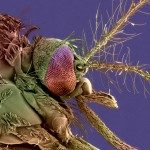Link to Pubmed [PMID] – 27390932
Link to HAL – pasteur-01473826
Link to DOI – 10.1186/s12879-016-1666-0
BMC Infectious Diseases, 2016, 16 (1), pp.318. ⟨10.1186/s12879-016-1666-0⟩
Background Dengue viruses (DENV) are comprised in four related serotypes (DENV-1 to 4) and are critically important arboviral pathogens affecting human populations in the tropics. South American countries have seen the reemergence of DENV since the 1970’s associated with the progressive re-infestation by the mosquito vector, Aedes aegypti. In French Guiana, DENV is now endemic with the co-circulation of different serotypes resulting in viral epidemics. Between 2009 and 2010, a predominant serotype change occurred from DENV-1 to DENV-4 suggesting a competitive displacement. The aim of the present study was to evaluate the potential role of the mosquito in the selection of the new epidemic serotype. Methods To test this hypothesis of competitive displacement of one serotype by another in the mosquito vector, we performed mono- and co-infections of local Ae. aegypti collected during the inter-epidemic period with both viral autochthonous epidemic serotypes and compared infection, dissemination and transmission rates. We performed oral artificial infections of F1 populations in BSL-3 conditions and analyzed infection, dissemination and transmission rates. Results When two populations of Ae. aegypti from French Guiana were infected with either serotype, no significant differences in dissemination and transmission were observed between DENV-1 and DENV-4. However, in co-infection experiments, a strong competitive advantage for DENV-4 was seen at the midgut level leading to a much higher dissemination of this serotype. Furthermore only DENV-4 was present in Ae. aegypti saliva and therefore able to be transmitted. Conclusions In an endemic context, mosquito vectors may be infected by several DENV serotypes. Our results suggest a possible competition between serotypes at the midgut level in co-infected mosquitoes leading to a drastically different transmission potential and, in this case, favoring the competitive displacement of DENV-1 by DENV-4. This phenomenon was observed despite a similar replicative fitness in mono-infections conditions.

